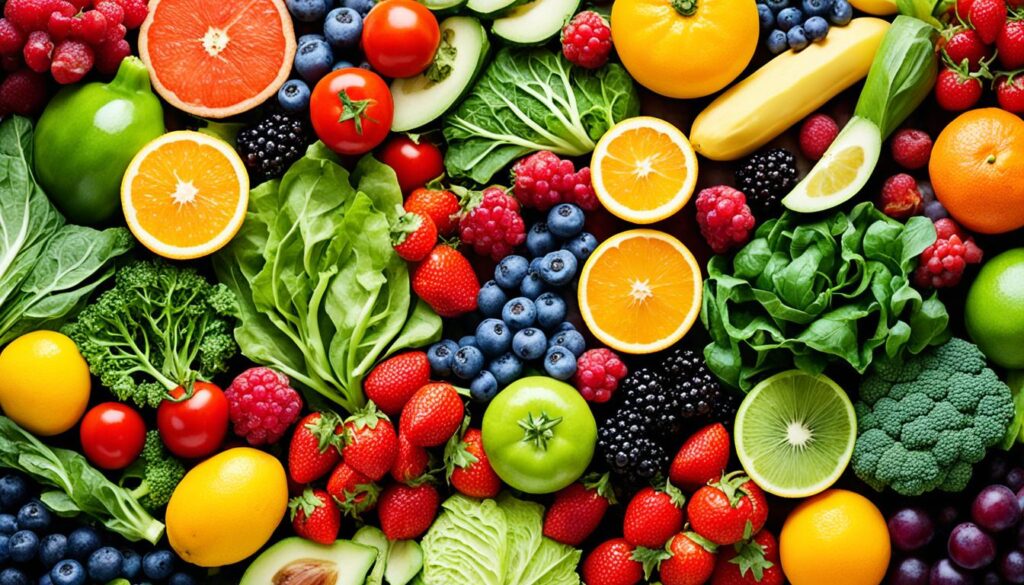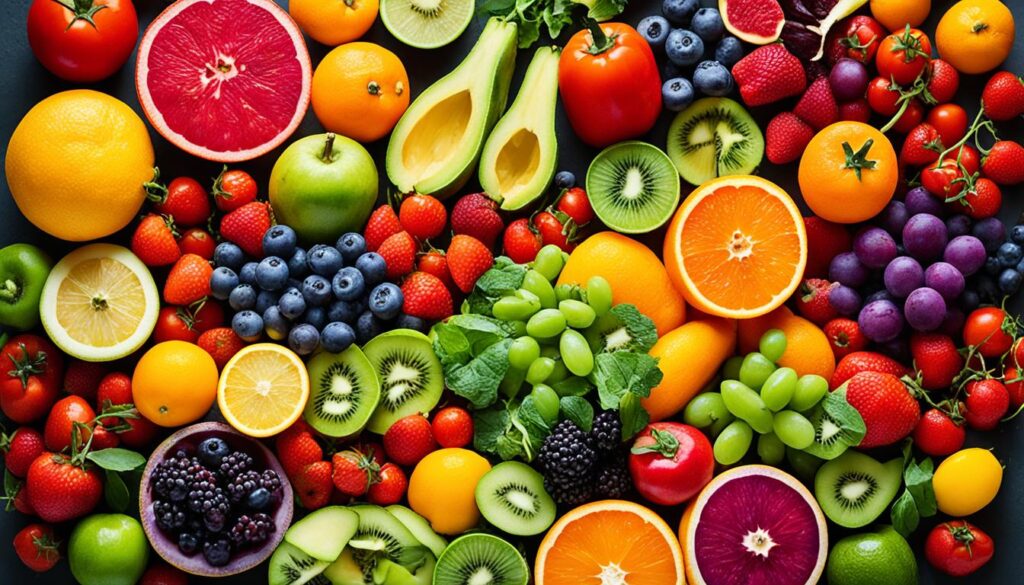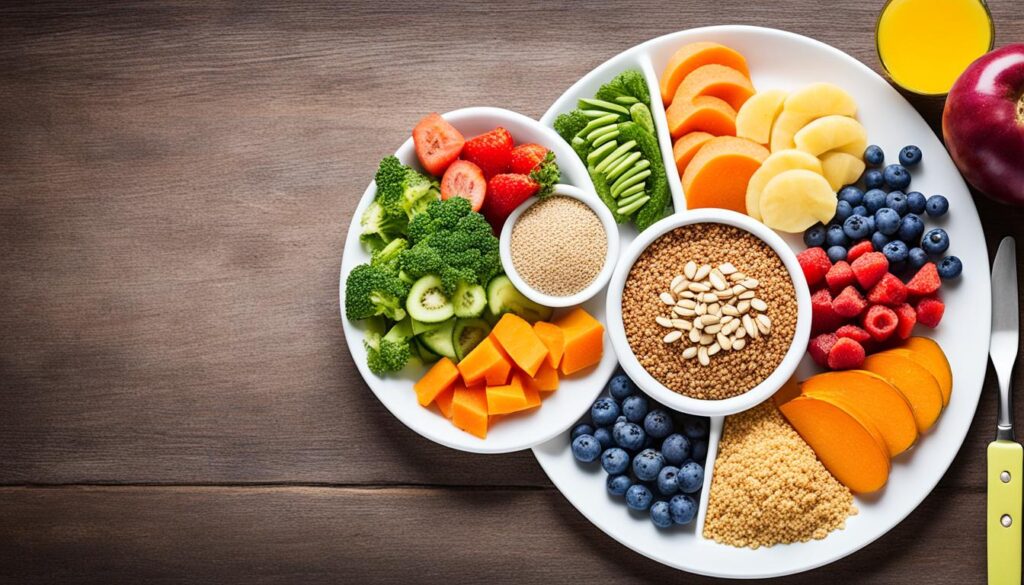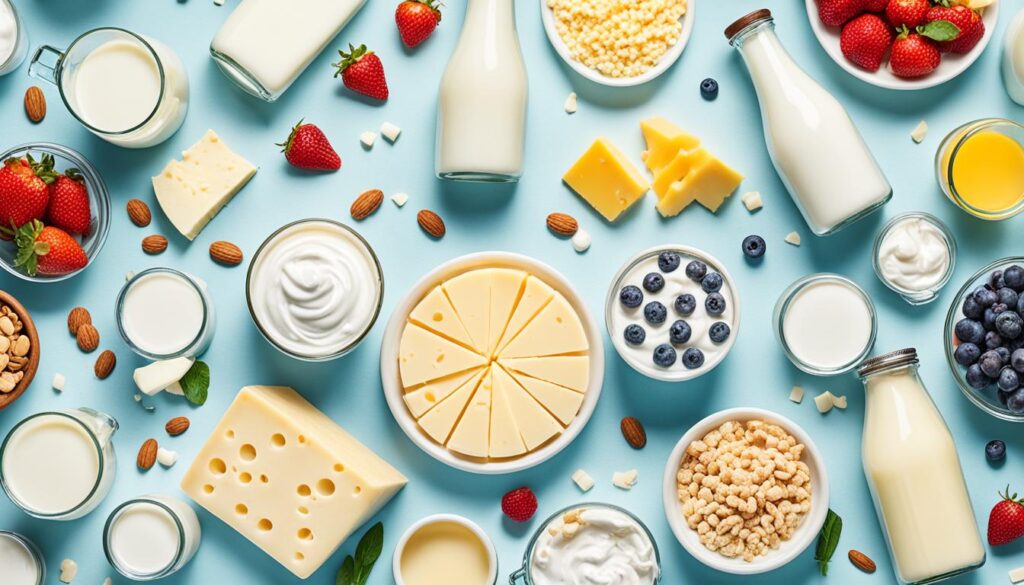A balanced diet is key for good health and getting essential nutrients. It means eating different foods in the correct amounts. This helps keep a healthy weight, fight off sickness, and feel good. It also gives us the energy we need every day.
Key Takeaways:
- A balanced diet is crucial for maintaining good health and providing essential nutrients.
- It involves consuming a variety of foods in the right proportions.
- Following a balanced diet can help prevent disease and promote overall well-being.
- A balanced diet provides the energy needed for daily activities.
- Consult with a healthcare professional or registered dietitian for personalized dietary advice.
Importance of a Balanced Diet
A balanced diet gives our bodies the needed nutrients for proper function. It reduces the chance of getting sick, tired, or performing poorly. Kids without a good diet might not grow well, do worse in school, and get sick often.
According to the Center for Science in the Public Interest, diet links to 4 major causes of death in the U.S. These include heart disease, cancer, stroke, and type 2 diabetes.
Food Groups in a Balanced Diet
To have a balanced diet, make sure to eat from all major food groups. The Eatwell Guide has great advice:
- Fruits and Vegetables: Try to eat five portions a day. Fruits and veggies come in many colors. They are packed with vitamins, minerals, and fiber needed for good health.
- Starchy Foods: Add foods like whole grains, potatoes, and pasta into your meals. Besides giving energy, they include fiber, vitamins, and minerals too.
- Milk and Dairy Products: Have some milk, cheese, or yogurt to get calcium and protein. Pick low-fat or fat-free kinds to keep saturated fats low.
- Protein Foods: Go for lean protein sources. This means lean meats, fish, eggs, beans, and legumes. They help grow and repair muscles with vital amino acids.
- Fats and Oils: It’s good to have some healthy fats. Use olive oil, eat avocados, nuts, and seeds. They support your health and help your body take in vitamins.

Eating various foods from these groups is key. It makes sure your body gets all needed nutrients for great health and feeling good.
Fruit and Vegetables: 5 A Day
Eating five portions of fruit and veggies daily is key for a good diet. You can choose from a variety: fresh, frozen, canned, or juice. Each portion is about 80g if fresh, canned, or frozen, and 30g if dried.
For example, a medium apple, a pineapple slice, or three heaped tablespoons of veg are one portion. Mixing fruits and veggies gives you vitamins, minerals, and fiber. It also lowers your chances of heart disease, stroke, and some cancers.
To hit your 5 portions daily, add fruits and veggies to everything you eat. Have a banana in the morning or put berries on your cereal. For lunch, go for a salad or a veggie sandwich. Snack on carrot sticks or have a piece of fruit. And don’t forget veggies with dinner.
Trying different fruits and vegetables adds variety to your meals. It makes your food more interesting and tasty.

Benefits of Incorporating Fruit and Vegetables
Eating more fruits and veggies has many upsides:
- Essential vitamins and minerals
- Dietary fiber for a healthy digestive system
- Natural antioxidants that protect against cell damage
- Hydration because many are full of water
- Lowers risks of heart disease, stroke, and some cancers
Don’t be afraid to try new fruits and veggies. Go for what’s in season for the best flavor and nutrition. Also, changing how you cook them, like grilling or steaming, can help you find new favorite dishes.
Nutritional Content of Common Fruits and Vegetables
| Fruit/Vegetable | Vitamin C (mg) | Potassium (mg) | Fiber (g) |
|---|---|---|---|
| Apple | 8.4 | 195 | 4.4 |
| Carrot | 5.9 | 320 | 2.9 |
| Broccoli | 84.7 | 316 | 2.6 |
| Strawberries | 58.8 | 153 | 2 |
| Banana | 10.3 | 358 | 2.6 |
Starchy Foods in a Balanced Diet
Starchy foods are key to a balanced diet because they give the body energy and nutrients. It’s better to choose whole grain and wholemeal over refined grains. Also, eating potatoes with their skins brings more fiber and nutrients for better health.
The Benefits of Whole Grain and Wholemeal Varieties
It’s best to pick whole grain or wholemeal options like brown rice, whole wheat pasta, and wholemeal bread. These are full of fiber, vitamins, and minerals, which is better than refined grains. Eating these helps your gut, keeps you full, and aids in keeping a good weight.
Emphasizing Potatoes with Skins On
Eating potatoes with their skins is great for fiber and nutrients. Bake or boil them instead of frying to keep your diet balanced. Potatoes are a good choice, whether as a side or in recipes, adding variety and key nutrients to your meals.
| Starchy Foods in a Balanced Diet | What to Choose | How to Prepare |
|---|---|---|
| Brown rice | Choose whole grain brown rice | Cook it in water or broth |
| Whole wheat pasta | Choose whole grain or wholemeal pasta | Boil it until al dente |
| Wholemeal bread | Choose wholemeal bread | Enjoy it as a sandwich or toast it |
| Potatoes | Choose potatoes with skins on | Bake or boil them for a healthy preparation |

Including whole grain and wholemeal starchy foods, as well as potatoes with their skins on, can contribute to a healthy and well-balanced diet.
Milk and Dairy Foods
Milk and dairy foods are crucial in a balanced diet. They offer key nutrients for health and wellbeing. These foods give us protein and calcium that are important for strong bones and growth. By including them in your meals, you improve your bone health and lower osteoporosis risk.
Choose dairy products that are lower in fat and sugar. Go for skimmed or semi-skimmed milk, reduced-fat cheese, and low-sugar yogurts. These choices offer nutrients but with less unhealthy ingredients. This makes your diet better for your health.
Remember, alternatives like soya drinks belong in this group too. But, pick unsweetened and calcium-fortified ones. This way, you ensure you get enough calcium.

Here’s an example of a table showcasing the nutritional content of various dairy foods:
| Dairy Food | Protein (g) | Calcium (mg) | Fat (g) | Sugar (g) |
|---|---|---|---|---|
| Milk (skimmed, 200ml) | 6 | 240 | 0.2 | 4.8 |
| Yogurt (low-fat, 125g) | 6 | 180 | 1.5 | 9.6 |
| Cheddar Cheese (reduced-fat, 30g) | 9 | 270 | 3.4 | 0.1 |
The table shows dairy’s high protein and calcium levels. It also notes their different fat and sugar amounts.
Eating these foods daily is tasty and good for you. You can have them alone or in your recipes. They are key to staying healthy and getting the nutrients your body needs.
Beans, Pulses, Fish, Eggs, Meat, and Other Proteins
Protein is key for the body’s growth, repair, and maintenance. It’s important to vary protein sources in your diet. This helps meet the body’s diverse requirements. Some top protein foods include:
Meat and Fish
Lean beef, poultry, and fish are great protein sources. They’re also packed with vital vitamins and minerals for health. Oily fish, like salmon, is full of omega-3 fatty acids, great for the heart.
Eggs
Eggs are not only economical but also rich in protein. They have all essential amino acids your body needs. Eggs boost your diet with valuable vitamins and minerals too.
Beans and Pulses
Plant-based proteins like lentils, chickpeas, and kidney beans are low in fat and high in fiber. They’re also rich in vitamins and minerals. Adding them to meals boosts protein and supports gut health.
Plant-based Proteins
Nuts, seeds, and soy products offer nutrients beyond protein. They’re rich in healthy fats, fiber, and various vitamins and minerals. They’re great for vegetarians and vegans too.
Variety in protein sources ensures you get all essential nutrients. Check the table below for protein comparisons between different foods:
| Protein Source | Protein Content (per 100g) |
|---|---|
| Chicken Breast | 31g |
| Salmon | 22g |
| Eggs | 13g |
| Lentils | 9g |
| Almonds | 21g |
| Tofu | 8g |
Protein needs depend on age, sex, and how active you are. It’s wise to get specific advice from a healthcare expert or dietitian.
Adding various protein sources to your meals helps keep you healthy. Try out different foods and cook them in new ways to get all their benefits.
Oils and Spreads in a Balanced Diet
Fat is key for our health, but we must limit how much we eat. Pick oils and spreads with care. For instance, olive and canola oils are great for meals and even better for your heart.
Cooking oils have different heat limits. An oil’s smoke point is when it starts to smoke and break down. Beyond this point, they can turn into unhealthy compounds. Olive oil suits lower heat dishes or for adding at the end.
Eat spreads warily, choosing those low in bad fats. Limit butter because of its saturated fats. Instead, go for nut butters, or spreads made from healthy avocados or olives.
Margarine is often seen as a butter replacement. If you choose margarine, avoid ones with trans fats. These can harm your heart. Pick margarine that’s marked trans fat-free.
Fats have more calories per gram than proteins or carbs. Eat them in moderation for a balanced diet and weight control. Aim for fats to be 20-35% of your daily calories, according to the American Heart Association.
Making smart food choices is at the heart of a balanced diet. By smartly choosing oils and spreads, your diet stays both delicious and good for your health.
Eat Less Saturated Fat, Sugar, and Salt
Eating too much saturated fat, sugar, and salt can lead to health problems. It’s crucial to limit foods high in saturated fat. These include processed meats, cakes, and fried foods. Aim for healthier choices to curb your cravings.
For less added sugars, avoid sweet drinks, candies, and desserts. While they taste good, they are bad for your health. They increase the chance of gaining weight and having tooth problems. Go for snacks like fruit or Greek yogurt with little sugar.
Salt makes food taste better, but too much is bad for you. High salt intake can up your blood pressure, which is bad news for your heart. To use less salt, switch to lower sodium options or foods with no extra salt. Try using herbs and spices for flavor. It will make your food taste great and lower your salt intake.
Tips for reducing saturated fat, sugar, and salt intake:
- Choose lean cuts of meat and trim off visible fat before cooking.
- Opt for baking, grilling, or steaming instead of frying.
- Replace sugary drinks with water, infused water, or herbal tea.
- Read food labels and select products with lower sugar content.
- Use natural sweeteners like honey, maple syrup, or stevia in moderation.
- Experiment with herbs, spices, and vinegar to add flavor to your dishes.
- Avoid adding salt to your meals while cooking and at the table.
- Gradually reduce the amount of salt you use in your recipes to allow your taste buds to adjust.
Changing your diet a bit and watching your saturated fat, sugar, and salt can make you healthier. It lowers the risk of getting sick.
Building a Healthy and Balanced Diet
Focusing on high-quality foods rich in nutrients makes our diet healthy and balanced. Make sure fruits and vegetables are a big part of every meal. Their various colors mean they’re packed with different healthy nutrients. These foods bring vitamins, minerals, antioxidants, and fiber for great health.
It is wise to choose whole grains over their refined counterparts. Whole grains like brown rice and whole wheat pasta bring more fiber, vitamins, and minerals. They also help keep your energy steady and your blood sugar levels in check.
Don’t forget to add lean proteins to what you eat. Things like fish, turkey, beans, and nuts are low in bad fats. They help your muscles grow, your tissues heal, and they keep your body going strong. Oily fish like salmon are full of omega-3s, which are good for your heart and your brain.
Healthy fats are important too. Choose olive oil for meals and cooking, it’s good for your heart. Avocados, nuts, and seeds are other great sources of these fats. They bring fatty acids and vitamins that our body needs.
Drinking enough water each day is vital for good health. It keeps our body working well and doesn’t add any calories. Tea and coffee are good too, just watch the sugar in the sweetened ones.
Don’t forget to move your body regularly. Activities like walking, cycling, or dancing are perfect. They help you stay at a healthy weight, keep your heart strong, and make you feel happy. Try to get moving for 150 minutes each week if it’s moderate activity, or 75 minutes if it’s more intense.
Following these tips and slowly changing how you eat can do wonders for your health. You’ll be on your way to a diet that does the best for your body and your future.
Conclusion
A balanced diet is key to good health. It gives the body the right nutrients it needs. By eating various foods in the right amounts, you lower the chance of getting sick. You also feel better overall.
To have the best health, it’s wise to follow a balanced diet. Eating fruits, veggies, whole grains, lean meats, and good fats can make a big difference. These foods are full of vitamins, minerals, and fiber. Also, drinking plenty of water and moving your body are important.
Remember, what you need to eat might be different from others. This is especially true if you have special health needs. Getting advice from a healthcare pro or a dietitian can help tailor your diet. They can help you meet your unique needs.
FAQ
What is a balanced diet?
A balanced diet is about eating various foods in the right proportions. This helps keep your body weight healthy. It gives your body needed nutrients and prevents diseases. Plus, it keeps you full of energy for your day.
Why is a balanced diet important?
Eating right gives your body what it needs to work well. It stops diseases and helps you avoid feeling tired. For kids, a good diet means they grow right and do well in school. The wrong foods can lead to heart disease, cancer, and more.
How can I achieve a balanced diet?
Creating a balance means choosing a variety of foods. Aim for five portions of fruits and veggies daily. Eat starchy foods like whole grains, and pick lean proteins. Also, use healthy oils and watch your fat, sugar, and salt intake.
How much fruits and vegetables should I consume for a balanced diet?
Meeting your daily fruit and veggie goal is key. You should aim for at least 5 servings. This might be a mix of fresh, frozen, or juiced produce. For each serving, think of an apple or a slice of pineapple. Ensure you eat different kinds for better health.
What are starchy foods and how much should I consume for a balanced diet?
Starchy foods are part of a good diet. They should make up a third of what you eat. Go for whole grain options like brown rice and whole wheat pasta. Including foods like potatoes with the skin can be healthy, too.
How can I incorporate milk and dairy foods in a balanced diet?
Milk and dairy are a great source of protein and calcium. Choose lower fat, lower sugar ones when picking dairy. Opt for dairy alternatives that are unsweetened and fortified with calcium, like some soya products.
How can I incorporate beans, pulses, fish, eggs, meat, and other proteins in a balanced diet?
These are important for your growth, repair and maintenance. Eat lean meats, fish, and eggs, which are rich in protein and nutrients. Include beans, pulses, and nuts as they promote a balanced diet with their fiber, vitamins, and minerals.
How should I choose oils and spreads for a balanced diet?
Healthy fats are good, but be mindful of how much you eat. Opt for oils like olive and canola. Avoid too much saturated and trans fats. Check food labels to choose the healthier options.
How can I eat less saturated fat, sugar, and salt for a balanced diet?
Too much of these can harm your health. So, cut back on saturated fats in foods like cakes. Also, lower your sugar intake by avoiding sugary snacks and drinks. Use spices for flavor, and pick low salt options to reduce your salt intake.
How can I build a healthy and balanced diet?
Start by picking high-quality, nutritious foods for your meals. Make fruits and vegetables the stars. Choose whole grains and lean proteins daily. Add in healthy fats like olive oil. Remember to stay active and drink plenty of water.
Where can I find personalized dietary advice for my specific needs and medical conditions?
For advice tailored to your needs, talk to a professional. A healthcare provider or a dietitian can suggest a diet that’s right for you. They’ll help you find what works best for your health.




















